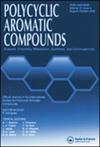作为有机太阳能电池敏化剂的新型芘基查尔酮衍生物的光物理和物理化学研究
IF 2.6
3区 化学
Q2 CHEMISTRY, ORGANIC
引用次数: 0
摘要
利用克莱森-施密特缩合技术合成了三种芘基查尔酮衍生物,即 PCH1、PCH2 和 PCH3。化合物 PCH1 通过慢速重结晶技术成功地...本文章由计算机程序翻译,如有差异,请以英文原文为准。
Photophysical and Physiochemical Study of New Pyrenyl Chalcone Derivatives as Sensitizers for Organic Solar Cells
Three pyrenyl chalcone derivatives namely, PCH1, PCH2, and PCH3 were synthesized by utilizing the Claisen-Schmidt condensation technique. Compound PCH1 was successfully recrystallized via the slow evaporation technique. To determine and refine the crystal structure, the single crystal is subjected to X-ray diffraction (XRD) analysis. Crystal packing reveals that intermolecular C-H···O interactions bind molecules in compound PCH1 in a head-to-head arrangement. Intramolecular charge transfer (ICT) between molecules has improved as a result of the compound’s C-H···O contacts. The compounds were then characterized using UV-Vis spectroscopy where all compounds have an energy gap that is within the low range, ranging from 2.89 to 2.94 nm. Furthermore, the HOMO-LUMO energy levels of the pyrenyl chalcones were examined by conducting CV analysis. The energy levels of the compounds essentially lie between the conduction band of TiO2 and the redox potential () of the electrolyte. FESEM and EDX analyses were utilized in solar cell performance investigations to examine the surface topography and elemental mapping of the pyrenyl compound on the TiO2 layer, correspondingly. Compound PCH2 emerges as the most effective dye-sensitizer in DSSC applications due to the anchoring of strong substituent groups in the compound, even though all three compounds demonstrated suitability as dye-sensitizer materials.
求助全文
通过发布文献求助,成功后即可免费获取论文全文。
去求助
来源期刊

Polycyclic Aromatic Compounds
化学-有机化学
CiteScore
3.70
自引率
20.80%
发文量
412
审稿时长
3 months
期刊介绍:
The purpose of Polycyclic Aromatic Compounds is to provide an international and interdisciplinary forum for all aspects of research related to polycyclic aromatic compounds (PAC). Topics range from fundamental research in chemistry (including synthetic and theoretical chemistry) and physics (including astrophysics), as well as thermodynamics, spectroscopy, analytical methods, and biology to applied studies in environmental science, biochemistry, toxicology, and industry. Polycyclic Aromatic Compounds has an outstanding Editorial Board and offers a rapid and efficient peer review process, as well as a flexible open access policy.
 求助内容:
求助内容: 应助结果提醒方式:
应助结果提醒方式:


